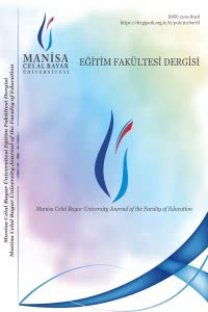İlköğretim Öğrencilerinin Fen Bilgisinde Öğretmenlerinden Algıladıkları Hedeflerin Araitırılması
Bu çalışma ilköğretim yedinci sınıf öğrencilerinin fen bilgisi dersinde, öğretmenlerinden algıladıkları hedefleri araştırmayı hedeflemiştir. Bu amaç için, Öğretmenlerden Algılanan Hedefler Ölçeği (Friedel, Cortina, Turner and Midgley, 2007) Türkçe’ ye adapte edilmiş ve 977 öğrenciye uygulanmıştır. Eşleştirilmiş iki grup arasındaki farkların testi ile öğretmenlerden algılanan ustalık hedefleri ile başarım hedefleri karşılaştırılmıştır. T-testi sonuçlarına göre, 7. Sınıf öğrencileri, fen bilgisi dersinde genellikle öğretmenlerinden ustalık hedeflerini algılamaktadırlar. Diğer bir değişle, öğrenciler, fen bilgisi öğretmenlerinin, öğrencilerin fen bilgisi ile ilgili yeni şeyler öğrenmekten hoşlanmalarını, ilgi duymalarını ve fen bilgisini anlamalarını hedeflediklerini düşünmektedirler.
Anahtar Kelimeler:
Hedef Yönelimi, Öğretmenler, Fen
Investigating Turkish Elementary Students’ Perceptions About Their Teachers’ Achievement Goals in Science
This study aimed to investigate Turkish elementary students’ perceptions about their teachers’ achievement goals in science classrooms. For this purpose Perceived Teacher Goal Emphases Scale, (Friedel, Cortina, Turner and Midgley, 2007) was adopted to Turkish and administered to nine hundred seventy seven 7th grade, elementary students. Paired sample t-test results was conducted to examine whether there is statistically significant mean difference between perceived teacher mastery goals emphasis and performance goal emphasis, or not. The results indicated that students generally perceive mastery goals from their teachers in science. In other words, elementary students generally think that their science teachers want them to enjoy learning new things, and understand science works.
Keywords:
Achievement goals, Teachers, Science,
___
- Ames, C. (1992). Classrooms: goals, structures, and student motivation. Journal of Educational Psychology, 84, 261-271.
- Ames, C., & Archer, J. (1988). Achievement goals in the classroom: Student’s learning strategies and motivation processes. Journal of Educational Psychology, 80 (3), 260–267.
- Anderman, E.M., & Maehr, M.L. (1994). Motivation and schooling in the middle grades. Review of Educational Research, 64, 287-309. Anderman, E.M. & Midgley, C. (1997). Changes in achievement goal orientations, perceived academic competence, and grades across the transition to middle-level schools. Contemporary Educational Psychology,22, 269-298.
- Anderman, E.M. & Urdan, T. & Roeser, R. (2003). The patterns of adaptive learning survey: History, development, and psychometric properties. For Indicators of Positive Development Conference, March 12-13, 2003.
- Bong, M. (2005). Within-Grade changes in Korean Girls’ motivation and perceptions of the learning environment across domains and achievement levels. Journal of Educational Psychology. 97(4),656-672.
- Deemer, S.A. (2004). Using achievement goal theory to translate psychological principles into practice in the secondary classroom. American Secondary education, 32(2), 4-15.
- Eccles, J, Wigfield, A., Harold Rena D., & Blumenfeld, P. (1993). Age and gender differences in children’s self- and task perceptions during elemantary school. Child Development, 6, 830-847.
- Eccles, J.S. & Wigfield Allan. (1995). In the mind of the actor: the structure of adolescents‟ achievement task values and expectancy-related beliefs. Personality and Social Psychology Bulletin, 21(3), 215-225.
- Elliot, A.J. & Harackiewicz J.M. (1996). Approach and avoidance achievement goals and intrinsic motivation: a mediational analysis. Journal of Personality and Social Psychology, 70(3), 461-475.
- Garner, R. (1990). When children and adults do not use learning strategies: toward a theory of settings. Review of Educational Research, 60(4), 517-529.
- Gutman, L.M. (2006). How student and parent goal orientations and classroom goal structures infuence the math achievement of African Americans during the high school transition. Contemporary Educational Psychology,31, 44-63. Kaplan, A., Gheen, M., & Midgley, C. (2002). Classroom goal structure and student disruptive behavior. British Journal of Educational Psychology, 72, 191-211.
- Kaplan, A., & Maehr, M. L. (2002). Adolescents’ achievement goals: Situating motivation in sociocultural contexts. In F. Pajares & T. Urdan (Eds.), Academic motivation of adolescents (pp. 125-167). Greenwich, CT: Information Age Publishing.
- Lau, S., Nie, Y. (2008). Interplay Between Personal Goals and Classroom Goal Structures in Predicting Student Outcomes: A Multilevel Analysis of Person–Context Interactions. Journal of Educational Psychology, 100(1), 15-19.
- Meece, J., Anderman E. M., & Anderman, L. H. (2006).Classroom goal structure, student motivation, and academic achievement. Annual Review of Psychology, 57, 505-528.
- Midgley, C., Kaplan, a., Middleton, M., & Maehr, M.L. (1998). The development and validation of scales assessing students’ achievement goal orientations. Contemporary Educational Psychology, 23, 113-131.
- Nichols, J. G. (1989). The competitive ethos and democratic education. Cambridge: Harvard University Press.
- Pintrich, P.R. (2000). Multiple goals, multiple pathways: the role of goal orientation in learning and achievement. Journal of Educational Psychology, 92(3), 544-555.
- Printrich, P.,,R.& Schunk, D., H. (2002). Motivation in education: theory, research and applications. Ohio: Merrill Prentice Hall.
- Wigfield, A., & Eccles, J.S. (2000). Expectancy-value theory of achievement motivation. Contemporary Educational Psychology, 25: 68-81.
- ISSN: 1309-8918
- Başlangıç: 2011
- Yayıncı: MANİSA CELÂL BAYAR ÜNİVERSİTESİ
Sayıdaki Diğer Makaleler
İlköğretim Öğrencilerinin Fen Bilgisinde Öğretmenlerinden Algıladıkları Hedeflerin Araitırılması
Dünyada ve Türkiye’de Sınıf Yönetimi
Abdulkadir TOKİZ, Fatma ŞAŞMAZ ÖREN
Teleskopla Ramazan Hilalini Gözlemlemek Sünnete Aykırı Mıdır?
Ankara Yerleişim Merkezinin, Çevresindeki Alanlarla Floristik Yönden Karşılaştırılması
